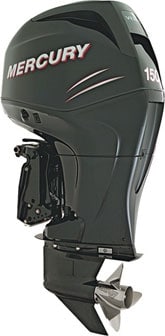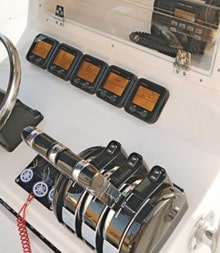
This month marks the centennial of the birth of the outboard, when Cameron B. Waterman filed a patent for his invention -then called a “boat-propelling device” -now known to be revolutionary. Marine-power options have come a long way since, and this year’s batch of fuel-injected, computer-controlled and -monitored offerings in outboard, inboard and sterndrive configurations are the cleanest, most fuel efficient and powerful power plants ever to take to the sea. Here’s a glimpse into the future of the engines that will drive fishing boats next season and for years to come.
Slim Twin
The 115 TLDI two-stroke outboard from Tohatsu America and Nissan Marine is environmentally friendly, but with the power of direct injection. Equipped with Two-stroke Low-Pressure Direct Injection, this 115 will work for single-engine fishing boats, but its slim profile also makes it a good choice for twin applications. The new 115 TLDI is EPA 2006 and CARB emission compliant through 2007. The air-assisted fuel-injection system on the 115 offers exceptional fuel and oil economy, while the single air intake reduces vibration and noise significantly. The TLDI system shatters fuel into tiny ten-micron droplets and positions the fuel plume optimally in the combustion chamber at the precise time for a complete burn, increasing efficiency while reducing emissions. The entire TLDI series of Tohatsu and Nissan engines are equipped with onboard self-diagnosis systems with features including an audible overheat sensor, an over-speed rev limiter that kicks in at 6,000 rpm and a warning light and buzzer for water temperature, oil level and battery voltage. Five-layer corrosion protection, power trim and tilt, a thermostatically controlled cooling system, start-in-gear protection and through-prop exhaust are also standard features on the 115 and all engines in the TLDI series. Tohatsu America and Nissan Marine; (972) 323-6003; www.tohatsu.com; www.nissanmarine.com
Wise Choice

The Crusader Captain’s Choice 8.1 MPI is an advanced gas-powered engine that develops 385 horsepower and over 500 pounds of torque. The 8.1 MPI is based on the famous General Motors Vortec block and uses MEFI-4, General Motors’ fourth-generation multi-port fuel-injection system that uses proven electronics to provide instant starting, smooth idling and solid performance along with a dose of fuel economy. The modular stainless-steel water pump is larger for more efficient cooling, and, best of all, the impeller can be changed without removing the pump itself. Fluid checks and filter replacement are within easy reach. Traditional tune-ups are eliminated by the distributorless ignition, which functions without such parts as points, rotor, condenser and cap, and reduces the number of moving parts overall for easy maintenance and durability. Fully CARB Ultra Low Emissions compliant, the 8.1 MPI is suitable for many inboard power applications. Crusader Engines; (586) 977-0100; www.crusaderengines.com
Lighten Up

The Suzuki DF-175 outboard is a powerful, efficient package wrapped in an anti-corrosion finish bonded directly to the aluminum alloy. Weighing in at 465 pounds, the 175-horsepower Suzuki is lighter than any competitive four-stroke. Featuring a new big-block in-line four-cylinder design with the largest displacement in its class, the 2,867-cubic-centimeter DF-175 has dual overhead cams and four valves per cylinder. The engine features Variable Valve Timing (VVT), a technological advancement shared with Suzuki’s proven 250-horsepower V-6 Four-Stroke. The continual adjustment of intake-cam timing by VVT maximizes performance while reducing emissions and increasing fuel economy. Lightweight forged-aluminum pistons allow the engine to gain revolutions more quickly for better throttle response. A three-piece composite intake manifold reduces engine weight and creates an efficient path for airflow, while Suzuki’s multi-stage induction system adjusts to engine speed to create improved combustion and optimal performance throughout the rpm range. Advanced digital sequential electronic fuel injection offers instant throttle response, improved fuel economy and low emissions. Suzuki Marine; (714) 996-7040; www.suzuki.com
Good Match

The Cummins MerCruiser QSB5.9 ES 230 Sterndrive is a fully electronic engine combined with a proven MerCruiser Bravo II-X sterndrive. The 5.9-liter in-line six-cylinder produces 230 metric horsepower at 3,000 rpm. With a high-pressure common-rail fuel system, this engine offers improved economy, a greater horsepower-to-weight ratio, and reduced emissions and noise. With the well-known Bravo II-X drive, the package can turn a 20-inch-diameter prop -well suited to get larger boats on plane quickly. The new QSB5.9 ES 230 utilizes the SmartCraft control and communication system, so information from engine and vessel sensors is transferred over a datalink to the helm, reducing necessary wiring. This package also meets or exceeds the new Tier 2 EPA Emissions regulations. Cummins MerCruiser; (800) 343-7357; www.cmdmarine.com
Strong Silent Type

Mercury’s 150-horsepower Verado four-stroke outboard offers many of the same features of its larger six-cylinder siblings. Built on a 1.7-liter, in-line four-cylinder platform, the 150 features dual overhead cams, four valves per cylinder, electronically controlled sequential multi-port fuel injection and the company’s patented sound-dampening technology. Torque and performance are enhanced by the supercharged and intercooled design. The supercharger compresses intake air, which is then cooled by the intercooler, increasing density as it enters the combustion chamber. These combined effects concentrate oxygen and create instant torque throughout the rpm range. An electronic valve maintains proper boost pressure and sends excess air back through the intake in the charge-air system. Throttle response is controlled by Mercury’s exclusive SmartCraft Digital Throttle and Shift (DTS), which uses data cable rather than typical push-pull control cables for smooth shifts and no-lag throttle control. SmartCraft is a CANbus system that monitors most vessel functions and integrates gauges and other instruments on the dash through a control module. The 150 is shipped with the Mercury Universal Steering Cylinder, but it can be upgraded by adding the electro-hydraulic power-steering coupling, a power-steering pump with a universal cylinder for power-assisted steering. Mercury Marine; (920) 929-5040; www.mercurymarine.com
Command and Control

With a full line of reliable outboard engines, Yamaha focused on its operational instrumentation and has released Command Link, an integrated information system to improve engine diagnostic accuracy and reliability. Based on CAN technology, a two-way digital protocol developed by the automotive industry, the system can communicate over a single bus with other vessel devices on the same network. Command Link will streamline installation and reduce wiring, weight and vessel complexity. Engine functions, sensors and engine-warning systems can be networked and controlled by a single system. Other Command Link features include engine-function information, fuel management, water depth, surface-water temperature, user selected on-board diagnostics and 100-hour maintenance interval reminders for routine upkeep. The new square Command Link gauges fit in the same holes as previous Yamaha gauges for seamless upgrades and repowers. The various gauges offer from four to 32 screen displays, with defaults set by the user. The fuel monitor will show consumption either independently or as a total for multi-engine applications up to four engines. Command Link also offers a combination speedometer and fuel-management gauge with 36 different displays and five default screens when used with an optional transducer and GPS. Yamaha; (800) 889-2624; www.yamaha-motor.com
Clean Machine

The 6LY3A-ETP from Yanmar Marine is a lightweight, turbocharged and intercooled in-line six-cylinder diesel. Rated at 480 horsepower at 3,300 rpm, the latest Yanmar has four valves per cylinder and uses technologically advanced electronic controls to regulate power and synchronize engine speeds in twin and triple applications. Using an NMEA 2000 CANbus system, the engine-control system offers a boat-wide network that provides engine information, including speed, percentage load, hours, battery voltage, coolant temperature, fuel level and usage rate, and boost and oil pressure. The torque-inducing high-pressure fuel-delivery system offers improved economy, reduced noise and decreased smoke and fuel odor. The engine complies with EPA Tier 2 emissions regulations. Yanmar Marine USA; (770) 877-9894; www.yanmarmarine.com
Improved Performance

The Honda BF225 four-stroke outboard is a large-displacement 24-valve V-6 engine with outstanding torque. The BF225 has a slim design that allows for mounting of dual engines on a 26-inch center-to-center distance, precluding the need for expensive transom modifications. The engine uses Honda’s Variable Valve Timing and Lift Electronic Control (VTEC) for excellent performance and efficient operation. A new engine control unit gives the outboard a simple, lean burn for five-percent better fuel economy. Multi-port programmed fuel injection delivers a precise fuel-air mixture to each cylinder for quick starts, low fuel consumption and instant throttle response, while a tuned dual exhaust reduces heat buildup. The engine uses a single-latch cowl for a watertight seal and is built to withstand corrosion with stainless-steel exterior components and Honda’s 4-Front corrosion protection. A fresh-water flush port helps further extend the life of the outboard. Honda Marine; (770) 497-6400; www.honda-marine.com
Driving Force

The Volvo Penta D12-800 diesel inboard is, at 775 horses, the most powerful engine built on the highly regarded D12 in-line six-cylinder block. With a ladder frame and vibration dampers on the camshaft, the engine has four valves per cylinder and the proven high-pressure unit-injected fuel system. Electronic-management technology and an electronically governed wastegate turbo ensure high power, low consumption and outstanding torque during acceleration with virtually no sign of smoke. A new heat exchanger and Engine Management System (EMS-2) allow the D12 to meet present and future emission requirements. Electronic Vessel Control (EVC) is the latest in vessel- and engine-control instrumentation and monitoring and uses just one CAN cable. EVC controls shift, throttle and twin-engine synchronization and comes with new easy-to-read data-link gauges or an optional LCD display. EVC can operate up to four separate control stations and uses waterproof connectors for plug-and-go installation. Volvo Penta; (757) 436-2800; www.volvopenta.com
Available Power

Weighing in at 419 pounds, the Evinrude E-TEC Saltwater 200-horsepower outboard is a direct-injected two-stroke V-6 that requires no dealer-scheduled maintenance for 300 hours or three years of normal operation. The Saltwater Edition engines go through 14 washing and rinsing cycles, a conversion coating, sealer, baked-on strontium-chromate primer and high-solid melamine top coat for maximum protection from salt water, increasing engine life. The Saltwater 200 features all the benefits of E-TEC including its high capacity alternator offering 15 amps of charging at idle or 500 rpm, and 50 amps from 2,000 rpm to wide open. The 50-amp output is 21/2 times that of competitive products. Another big plus with the Saltwater 200 is its CANbus connectivity, allowing boatbuilders and boaters to utilize the NMEA 2000 industry standard for instrumentation and navigation equipment to display engine and boat-performance data. The Saltwater 200 also benefits from E-TEC direct injection, which Evinrude says provides double the fuel efficiency of conventional two-stroke and supercharged four-stroke engines, providing extended range, increased power and better fuel consumption throughout the power range. Evinrude; (847) 689-7090; www.evinrude.com









